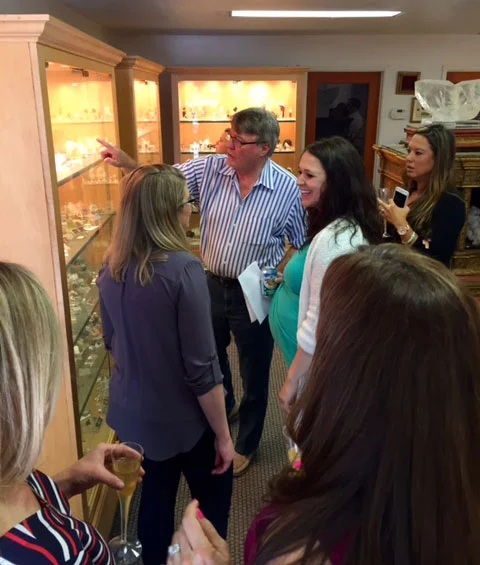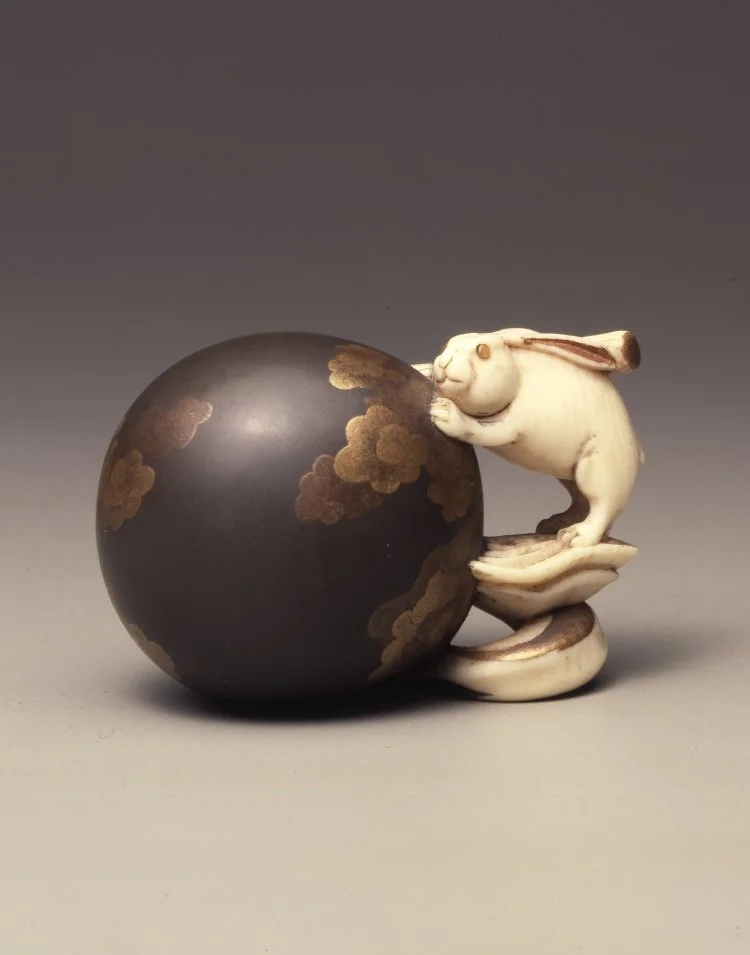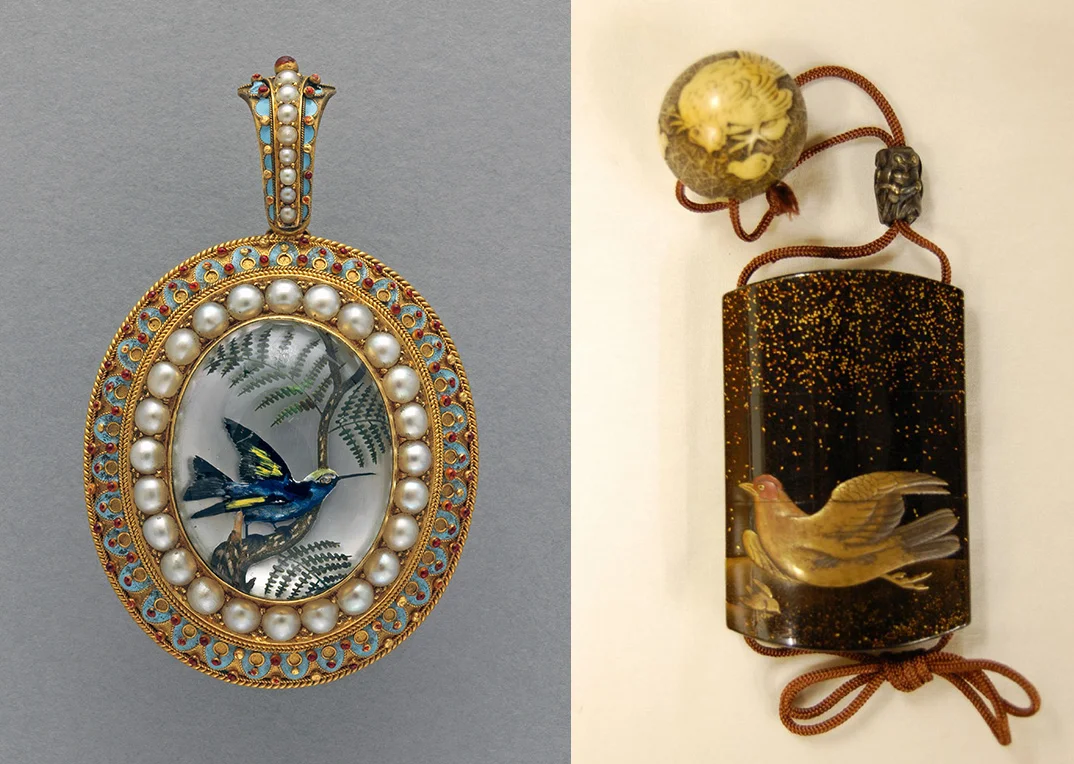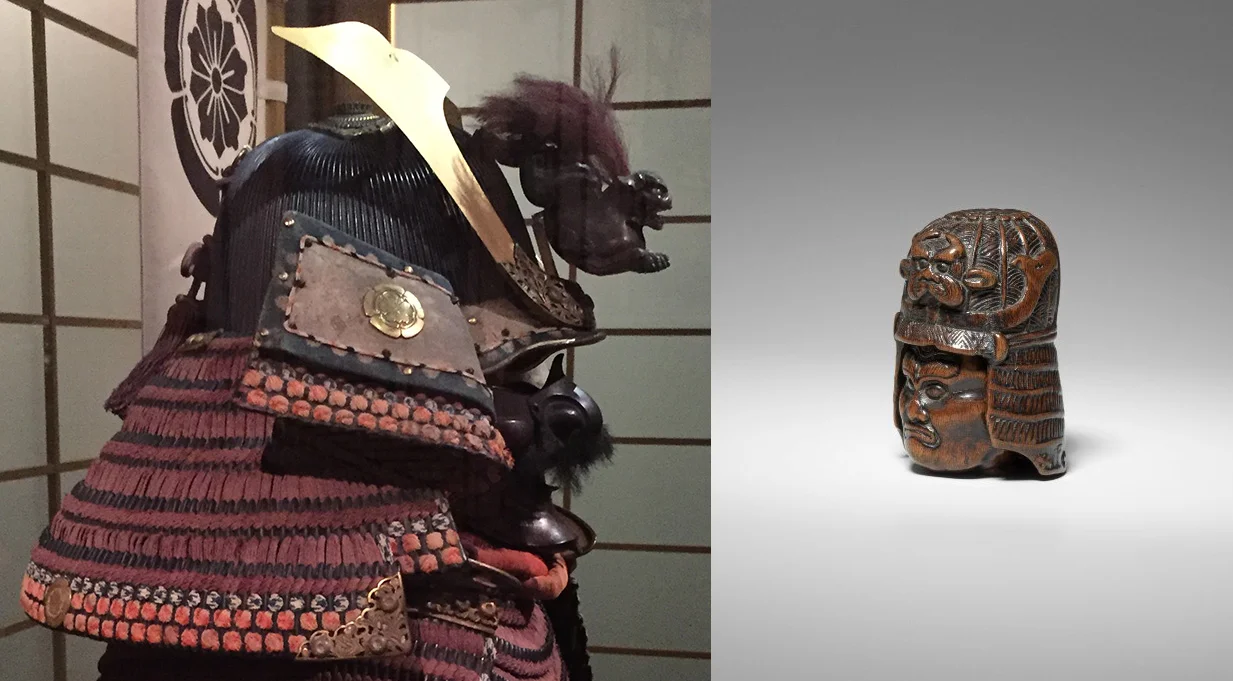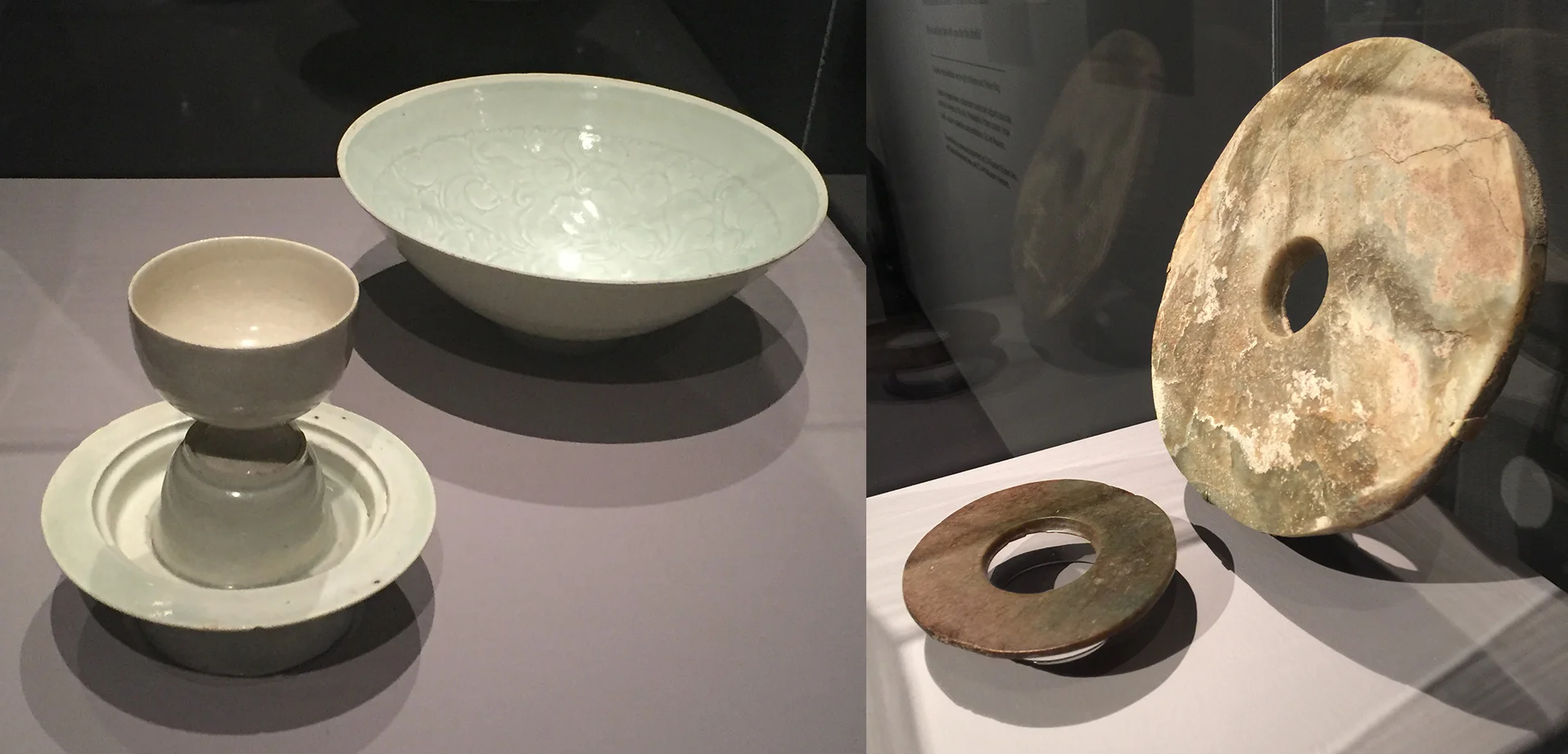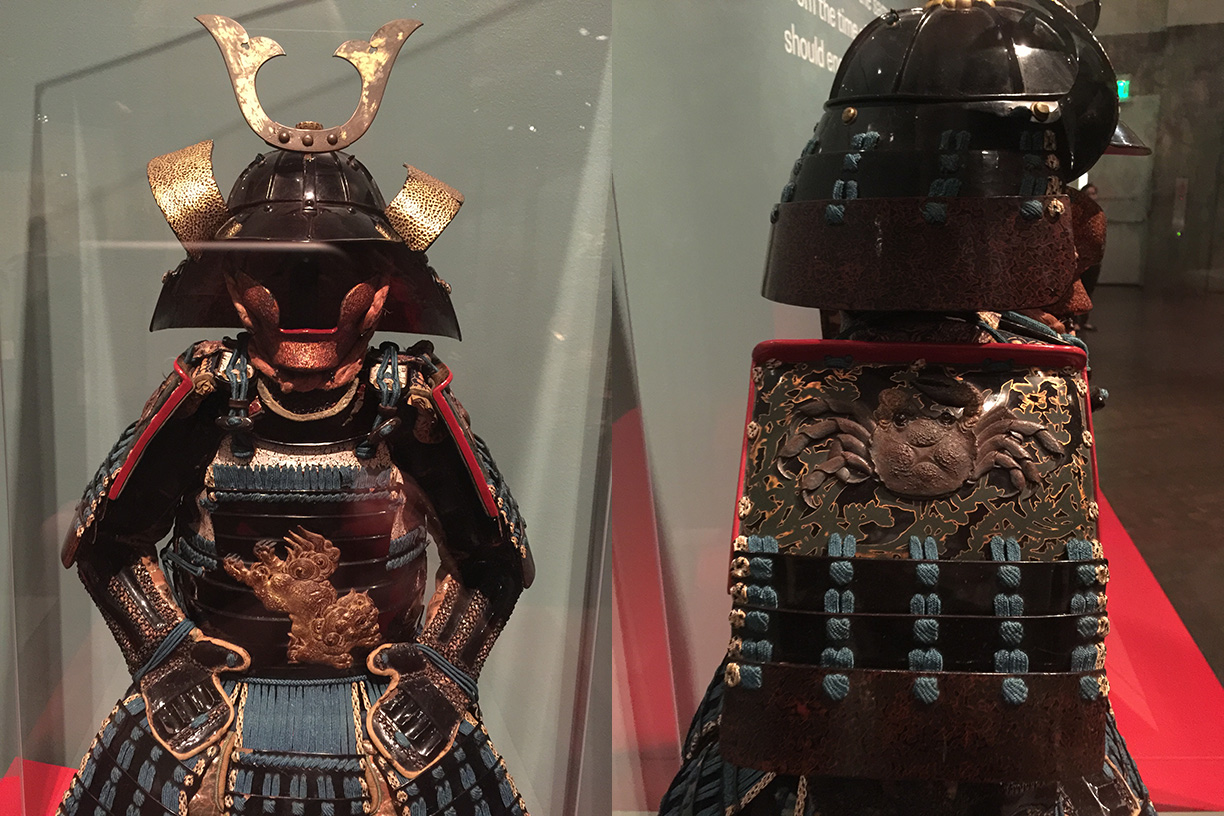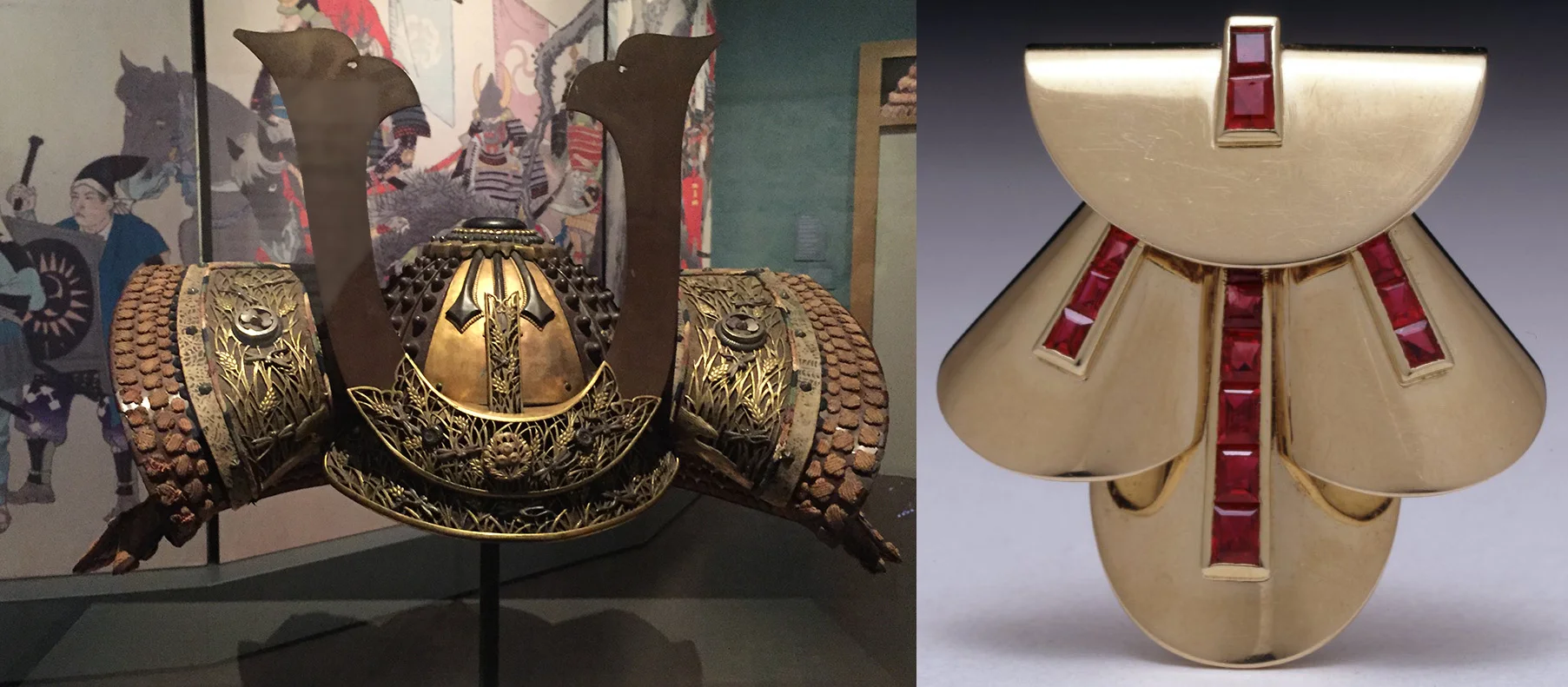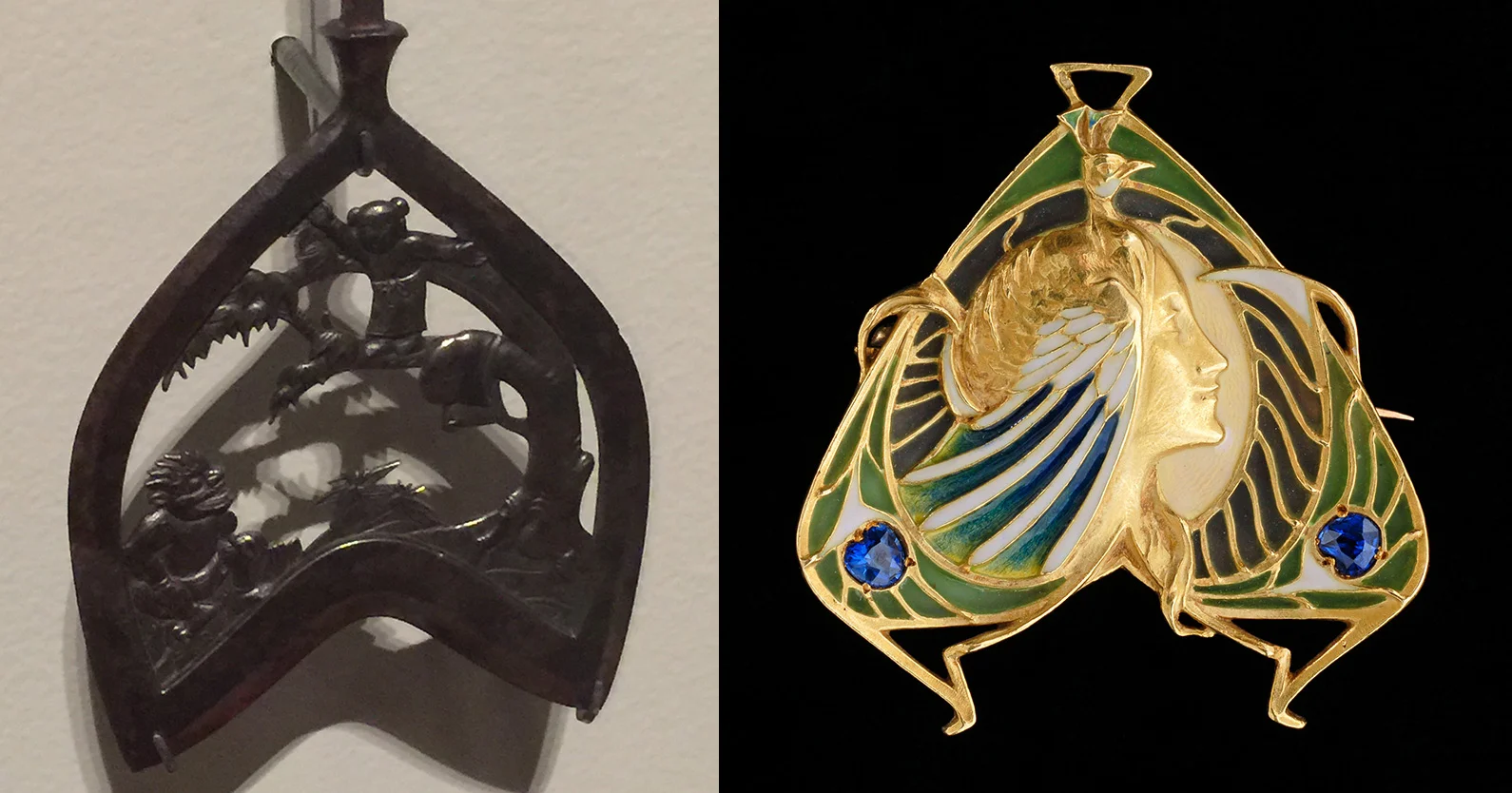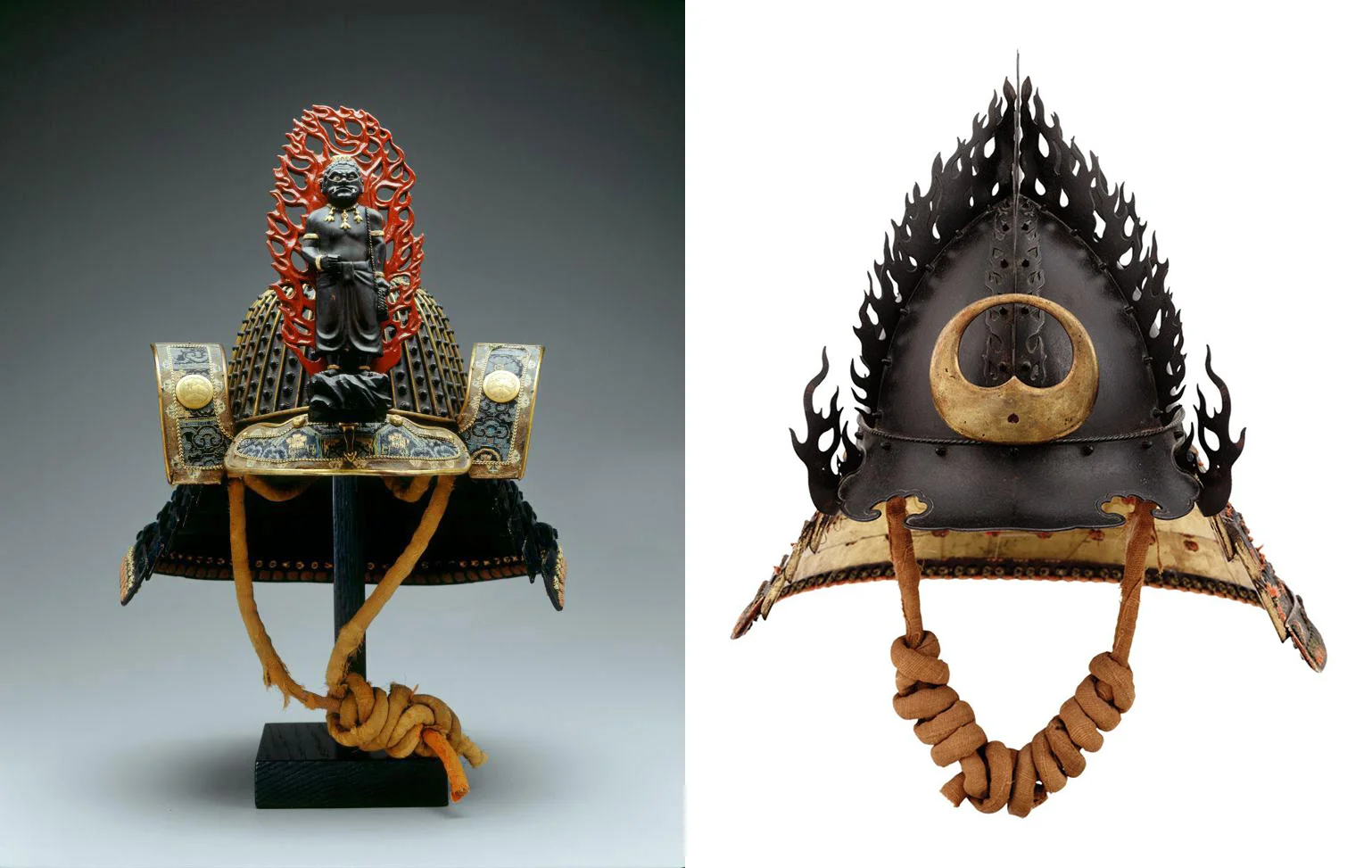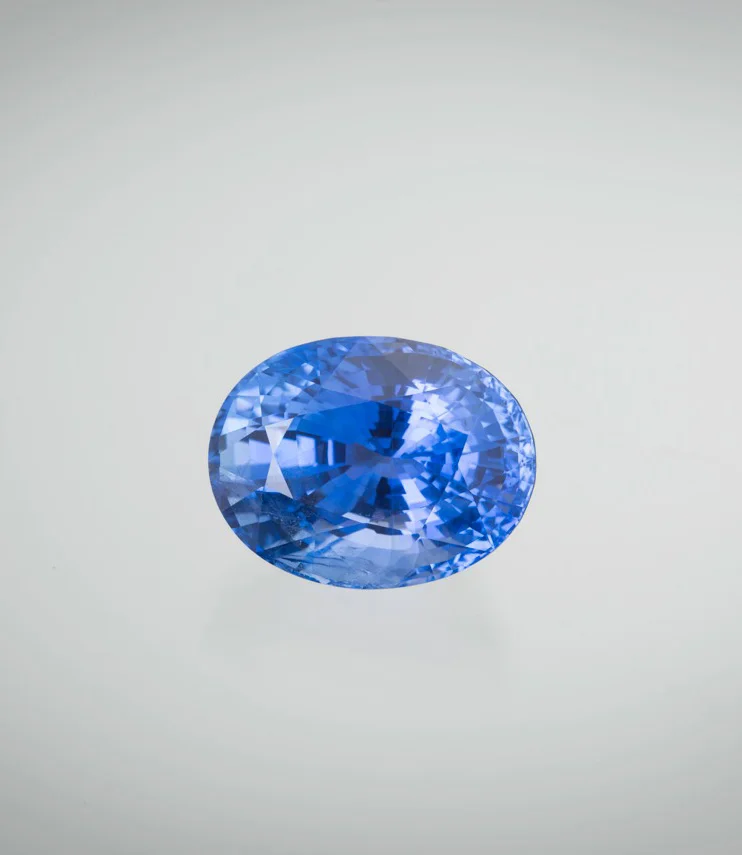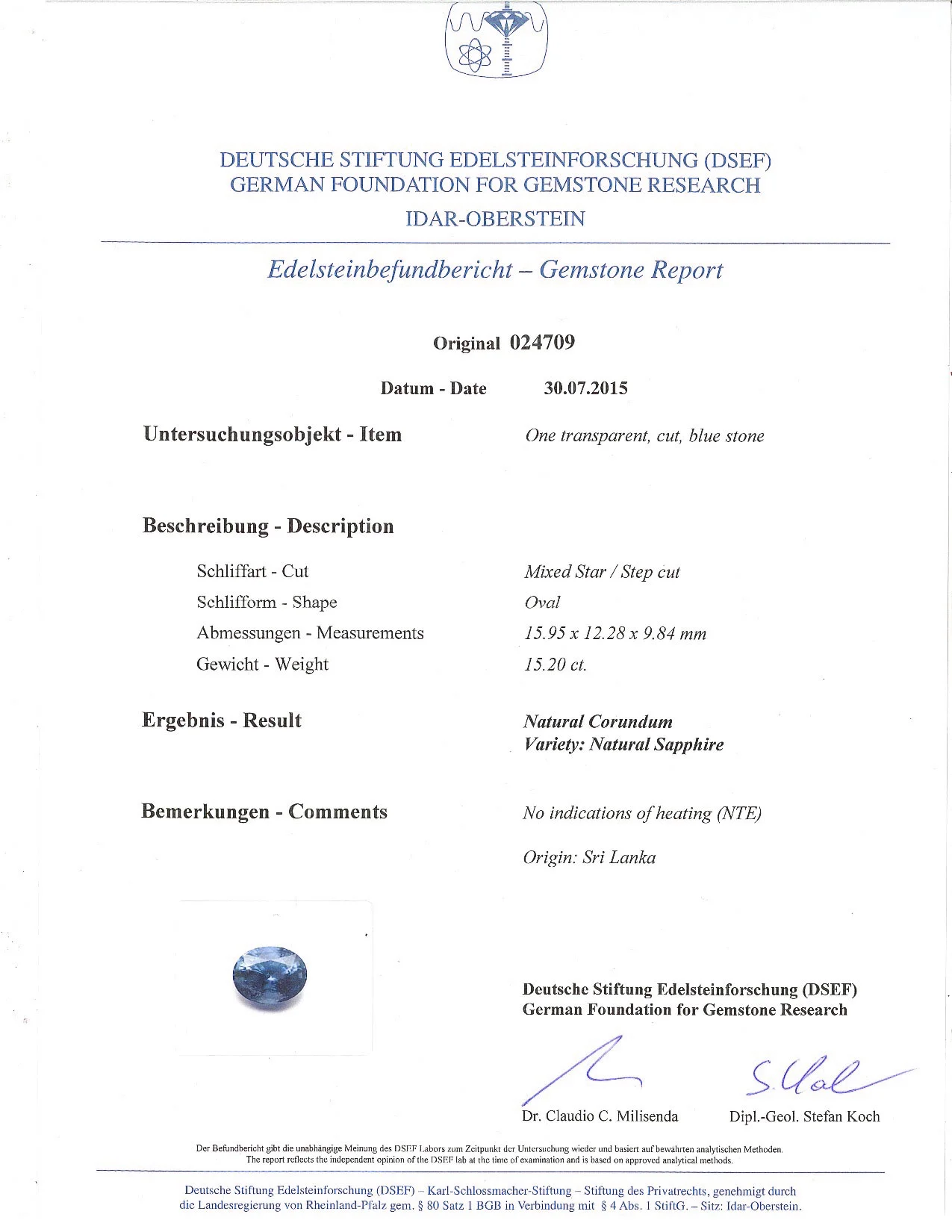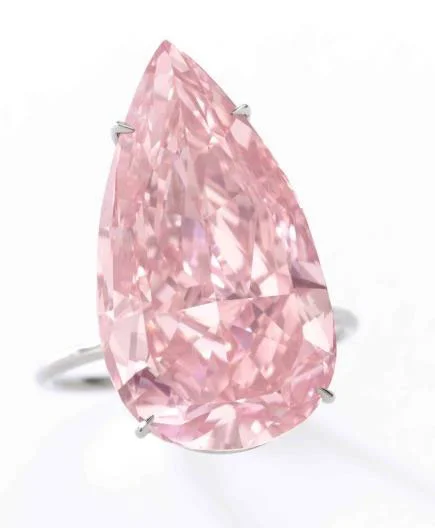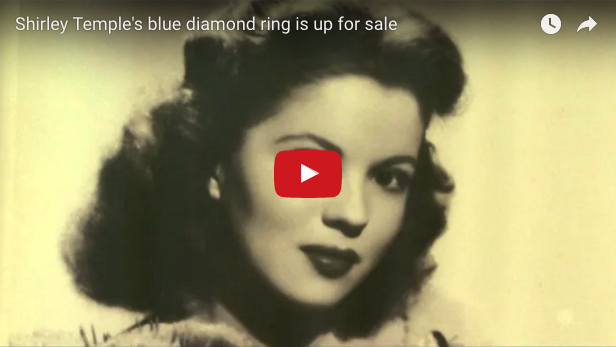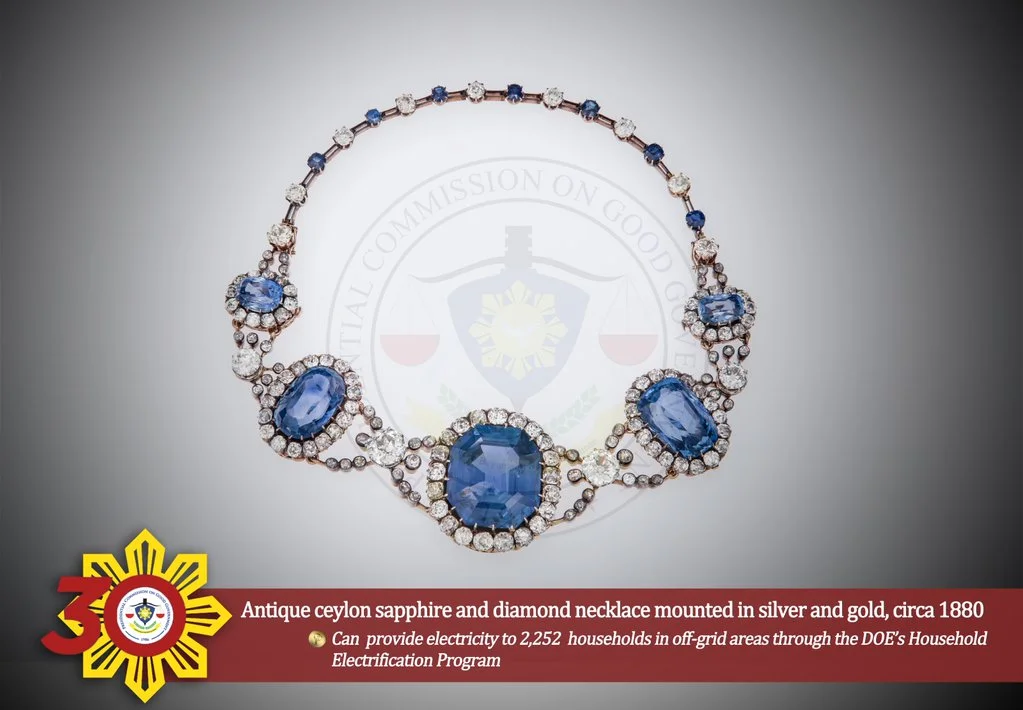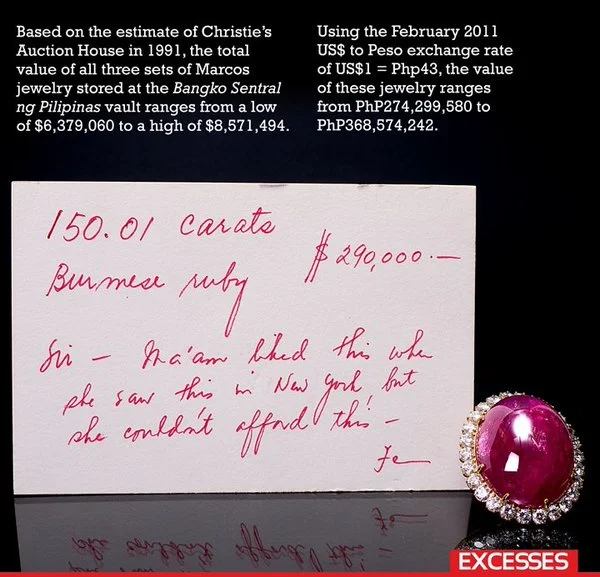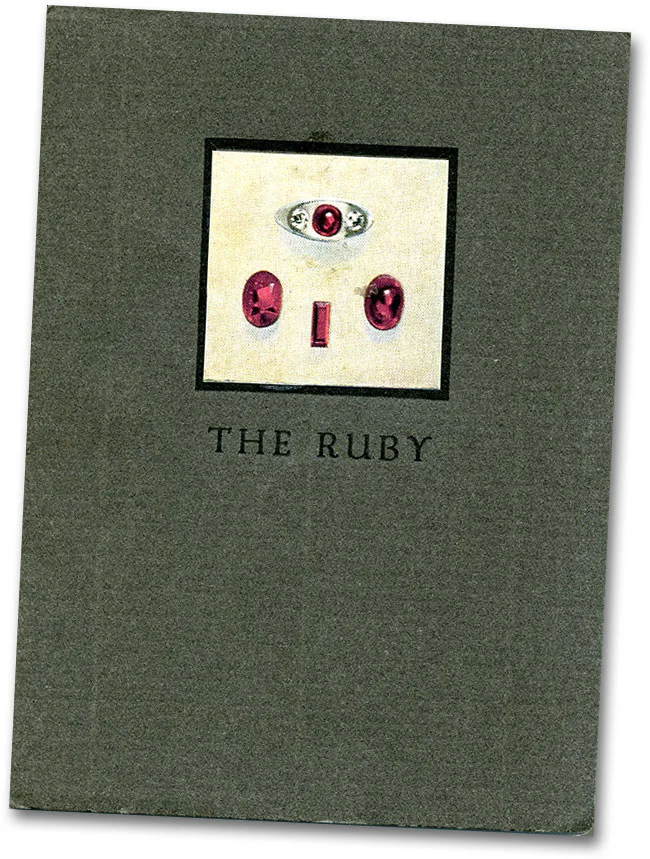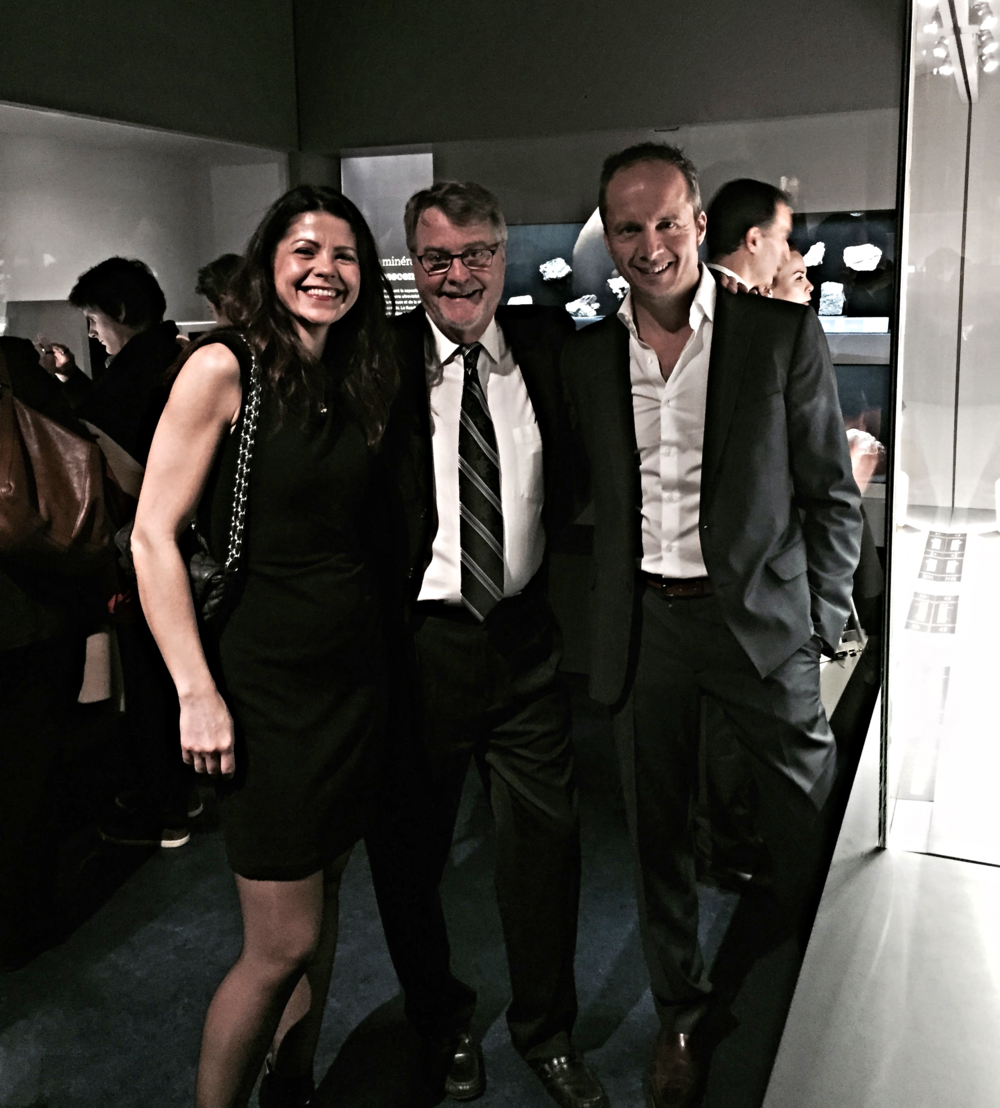April 2016
April 2016 Newsletter
On April 2, Pala International hosted a "Ladies Gem Day" for a group of officers' wives from nearby Camp Pendleton. The officers belong to Squadron HMLA-267, known as The Stingers. Pala's Bill Larson, center, and Will Larson led the tour of mineral specimens (notice the huge Japan-law twinned quartz in upper right-hand corner). On the gemstone side, Rika Larson and Geri Vigil continued the tour. (Photo: Geri Vigil)
Table of Contents
Shows and Events
Pala International News
Gem and Gemology News
Industry News
Pala Presents
- The Ruby
Published by H. J. Howe, Jeweler, Syracuse, New York
Recycle Bin
Editor: David Hughes
Shows and Events
Pala at Las Vegas: June 2–6, 2016
It's time to plan for the JCK Las Vegas show. Pala International will be there in force, with one of America's largest selections of fine colored gems.
Note: The JCK Show this year will run Thursday through Monday.
What: AGTA GemFair
When: June 2–6, 2016
Where: South Pacific and Islander Ballrooms in the Mandalay Bay Convention Center, Las Vegas, NV
Hours: AGTA Gemstone Section
Thursday, June 2 thru Sunday, June 5: 9:30 AM – 6:00 PM
Monday, June 6: 9:30 AM – 4:00 PM
Booth: AGTA Pavilion, booth AGTA514
We look forward to seeing our many friends there. Visit the Pala International Show Schedule for future events.
A message from the Larsons
Before we engage in a survey of Asian treasures…
As many of you may know, my wife Rika is from Japan and so the devastation in Kyushu really hit home for us. We were lucky that our family members and friends are safe, but many other families are affected by this earthquake. I personally lost my friend Shinobu in the 2011 earthquake and know just how devastating this can be for families. We hope that any of you who feel in the giving spirit will consider donating to a Kumamoto relief fund of your choice. The survivors are in need of a lot of help right now as there is not enough food, water, baby supplies such as diapers and formula to go around. I know they will get through this tough time, but every little bit helps. Thank you so much and we are sending positive thoughts to all the Japanese families affected by this devastating earthquake.
— Will and Rika
Flaming Jewels
The aged nun Eshun sat on her own funeral pyre. "Is it hot in there?" asked a monk. "Only a dunce would be concerned," she replied, as the flames turned her to ash.
— Zen koan paraphrased
A whole world. Netsuke, hare with pestle and globe, lacquered ivory, 4.4 cm. Bequeathed by Anne Hull Grundy. (Photo © The Trustees of the British Museum)
When your editor lived in Los Angeles, one small pleasure was spending time at LACMA's Pavilion for Japanese Art browsing the Raymond and Frances Bushell Collection of Netsuke. Like thumbnail mineral specimens, netsuke are tiny sculptural objects portraying a single subject, or evocative of an entire world (or both). Ostensibly they are practical items that provide a solution to a problem: traditional Japanese clothing, influenced by Chinese fashion of the first millennium C.E., has no pockets. Where to put tobacco, herbs, money and such? The answer is little lacquered boxes, such as the inro—a sectional stacking container held together by pendulous cords that allow the lid and sections to slide up and down securely. Rather than thread the inro's looped cord through the garment's obi, or sash, the loop is terminated by the netsuke. This is slipped underneath the obi from below, acting as a toggle preventing the inro from falling from the sash. To further secure the inro's lid and sections, the cords are threaded through a bead-like ojime fastener that is pulled up to loosen, or down to tighten, the sections of the inro. Even the ojime can be a work of miniature artistry.
By contrast, some time back my mother, Phyllis J. Hughes, alerted me to the jewelry collection of Anne Hull Grundy (1926–1984) housed at the Fitzwilliam Museum, at the University of Cambridge, England. (My mother is a genealogist, specializing in the Hull surname; she's a Hull and through her so am I, thus the interest in Hull Grundy.) Last September, I contacted the Fitzwilliam, which celebrates its bicentenary this year, but there were challenges in providing me with images from the Hull Grundy collection, which is not yet on display. Meanwhile, I was told by Helen Ritchie, a Department of Applied Arts research assistant, "Mrs Hull Grundy gave collections of jewellery"—considered one of the world's finest—"to museums all over the UK, including Glasgow, Doncaster, Harrogate, Cheltenham, and Birmingham, whilst saving the best pieces for the British Museum. The BM pieces are all searchable on their collection online and were also fully published in a two volume work." Ms. Ritchie also told me she's researching the Fitzwilliam's jewelry collection over the next two years or so, which hopefully will result in an exhibition and/or publication.
Tweet. At left, a pendant from about 1873 produced by William James Thomas, London, exhibited at the World Exhibition 1873 Vienna. Its center scene is a reverse crystal intaglio, mounted in gold surrounded by pearls and enamelwork, 5.9 x 3.7 cm. It contains a compartment in back for a photograph or lock of hair. At right, a three-case inro by Shibyo, undated, made of takamakie lacquer. Shown is the reverse, depicting a hen and her chick; the cockerel is on the obverse. The ivory netsuke, by Issai, depicts the hen and two chicks; its obverse, the cockerel. The silver ojime bead, maker unknown, is in the form of an owl and other birds. Both objects bequeathed by Anne Hull Grundy. Click to enlarge. (Photos: left, © Fitzwilliam Museum, Cambridge; right, © The Trustees of the British Museum)
I went to the British Museum's website to peruse the Hull Grundy collection and, to my surprise, the first items were not, say, Lalique rings or jewels by architect Henry Wilson (designer of the famous bas-relief doors of Saint John the Devine in New York). Instead, the first objects were dozens of ojime and netsuke! Finally, on Monday I was sent the Fitzwilliam images, but I already had wanted to introduce readers (if not already acquainted) to something somewhat afield from the world of colored gemstones: design aspects of elaborate samurai armor (via the current Denver Art Museum show, Samurai) contrasted with the simplicity of Chinese burial objects (in Life and Afterlife at the CU Art Museum). There appears to be a thread, or a cord, stringing this together.
Anne Hull Grundy, Collector
Anne Hull Grundy, née Ullmann, was born in 1926 into a Nuremberg Jewish banking and industrial family, which left for England upon Hitler's rise to power in 1933. Her father re-launched the family's toy business in Northampton. The family's post-war success came from its die-cast toys under the Corgi name as well as its Keyser-Ullman bank. From this wealth, Hull Grundy was able to amass her jewelry collection, which she began at age eleven, inspired by her parents. In 1949, Anne married John Hull Grundy (1907–1984), an artist and author who lectured in Entomology at the Royal Army Medical College, London, being named an MBE upon his retirement in 1967. Even though she had been disabled by a respiratory condition at twenty-one, becoming bed-bound, she threw herself into the study and collecting of European jewels and Japanese objets d'art. From her bed she acquired thousands of pieces, mostly by mail.
Fat cat hat. From Samurai, the helmet at left is signed by Bamen Tomonori of Yoyohara, its mask by Myochin Muneo, both of the Edo period, 1615–1868. A lion leaps from the helmet's brow. At right, a netsuke from the Hull Grundy collection at the British Museum. It depicts the severed head of a helmeted warrior. While the creature on its helmet does not leap, in this netsuke the helmet is detached from the head. Made of wood that resembles dark ivory, it measures 4.7 x 3.3 cm. Click to enlarge. (Photos: left, David Hughes; right, © The Trustees of the British Museum)
Anne did receive dealers, however, one recalling how she was covered by furs and flanked by cases of netsuke and mahogany cabinets of jewels. Pigeons flew through the open French windows, attracted by the grain she threw, as were wasps, attracted by a pile of dozens of overripe pineapples. "Mrs Grundy grew sleepy on the effects of fried bananas and miniature bottles of champagne," recalled the dealer, as recorded by Marjorie Caygill in "Creating a Great Museum: Early Collectors and the British Museum" (archived here). Caygill writes, "It is noted that: 'If the museum directors seemed less than prompt in thanking her for her gifts, then a barrage of telegrams would be sent containing overt threats of legal proceedings and even mutilation.'" She threatened to haunt the British Museum following her death if a catalog of her collection was not published. It was—in two volumes (The Art of the Jeweller: A Catalogue of the Hull Grundy Gift to the British Museum, 1984).
Circles. From Life and Afterlife. At right, two perforated jade disks, or bi, are displayed. They were used in Neolithic burials, with the disks placed at intervals around the deceased. Historical texts describe the bi's shape as being symbolic of heaven. What's remarkable about these and their dating is that jade was not easily carved in the Neolithic period. The larger disk is from the Liangzhu Culture, 10th millennium–21st century B.C.E. The smaller disk is from the Xia Culture, Shang Dynasty of the Late Neolithic, 10th millennium–11th century B.C.E. Quingbai porcelain, at left, was developed in the late 10th and early 11th centuries C.E. Delicate in form, it actually is sturdy, and its celadon glaze is a personal favorite of your editor. The cup and stand, from the Northern Song Dynasty (10th–12th century C.E.) would have been from a set used to warm alcoholic drinks. (Photos: David Hughes)
Life and Afterlife
Life and Afterlife: Selections of Ancient Chinese Art From the King Collection puts on display 59 of the 224 objects that Walter and Shirley King bequeathed the University of Colorado Museum of Art in 2012. The items in the exhibition roughly can be grouped into four areas, according to Hope Saska, curator of collections and exhibitions: sustenance (a miniature ceramic stove, for instance), protection (a spearhead, a barking dog), service and entertainment (bowls and beakers), and status (bronze items versus clay). The exhibition is up through June 26, 2016.
Circles: Accessoires cabochon. At left, from Samurai, a military hat, signed by Myochin Muneakira, mid Edo period, 1700s, iron, gold and copper. (On another piece he boasted that he was Japan's best armorer.) The hat's graceful, even delicately detailed dragon with its golden eye (click to enlarge) was created using a repoussé technique, i.e., hammering the designs in reverse from below. At right, from Life and Afterlife, a bronze mirror featuring animal figures, of the Han Dynasty (third century B.C.E.–third century C.E.), which also brought Japan its now-traditional robe that we know as kimono. What look to be dark cabochon gemstones actually are part of the bronze material. This is the most ornate piece in Life and Afterlife, and probably one of the latest in the exhibition. (Photos: David Hughes)
Samurai
The objects in Samurai: Armor from the Ann and Gabriel Barbier-Mueller Collection are as ornate, as those in Life and Afterlife are austere. They also come from a much later time period—the 12th through the 19th centuries C.E. (The samurai story begins in the late 8th century when Japan ended conscription and provincial landowners were on their own to provide defense.) The loaning museum in Dallas, Texas, which opened in 2012, is the only museum outside Japan devoted to the subject of samurai armor. Its nearly one thousand objects continue to grow.
Star Wars, late Edo period. A boy born into a samurai family was given a wooden sword at about age six, at which time began six more years of martial arts training but also education in the humanities, including calligraphy. At about age twelve he was presented with a suit of armor like this one, from Samurai, which likely was given to a boy even younger. It is from the 1800s, crafted of iron, lacquer, gold, wood, lacing and fabric. The breastplate features a gilt komainu, lion-like guard dog, with open mouth. To this viewer, the shoulder-plate crab depicted on its bed of near-calligraphic sea vegetable is apt, due to its "armor" but also because to Buddhists it represents the sleep of death—the period between incarnations, which can be applied to the time between adolescence and adulthood. Click to enlarge. (Photo: David Hughes)
In his essay for Asian Art on this traveling exhibition, Martin Barnes Lorber writes that samurai armor is distinctive for a number of reasons. Unlike European armor, it is lightweight. Its material varies, and its construction not only deflects, but absorbs the energy from a blow; thus Lobber likens it to modern-day Kevlar. And, of course, for our purposes, it is far more decorative—the helmets, masks, shin guards, etc.—, and thus transcends an "impression as objects of practical use."
Built to last. Something vaguely samurai is going on with the gold and ruby dress-fitting at right—or perhaps we're reminded of the broad, bowl-shaped (and face-masking) woven hat (takuhatsugasa) and robe worn by Buddhist monks. The pin, designed by Asprey, London, was purchased by Hull Grundy in 1939. It features 14 calibré-cut rubies and is displayed at the British Museum along with a scarab-shaped lapis lazuli pendant and matched set blood-red fire opal ring and pendant. The mid Edo (ca. 1730) helmet at left, from Samurai, is itself modeled on a 13th century design named for the rows of rivets (oboshi) protruding from its surface. It was made by Munemasa, the twenty-fifth master of the Myochin school, which still exists after four centuries. Long-lasting also are the helmets made by such schools; whereas armor might eventually fall into disrepair, helmets especially were passed on down the generations. Click to enlarge. (Photos: left, David Hughes; right, © The Trustees of the British Museum)
Samaras and samurai. At right, he same helmet from Samurai is shown in more detail, revealing gilded openwork plates depicting a pattern of grain over which silvered iron dragonflies flit. At left, a convex choker plaque from the Hull Grundy collection at the British Museum. Using turquoise and green plique-à-jour enamels on gold, the unnamed maker depicts sycamore leaves and samaras (winged seed pods), the seeds being small pearls. Thrown in for good measure are baroque pearls on stems, possibly depicting the tree's buds. The plaque, created ca. 1900, measures 5 x 7.3 cm. Click to enlarge. (Photos: left, © The Trustees of the British Museum; right, David Hughes)
In his essay, Lorber also heaps praise upon the Samurai exhibition catalog, calling it "the largest and most complete reference book on Japanese armour in a Western language since John Anderson’s Japanese Armour was published over 40 years ago." The volume has ten contributors. Published in association with Yale University Press, it is offered in Denver only in paperback, but an elegant one at that. Hardcover and paperback are available at the museum in Dallas.
Heads and tails. Left, from Samurai, an iron "arrowhead" (yanone) from the Edo period (1615–1868). These were used as offerings or gifts. Usually displaying family crests, this one depicts a folktale story in which a child climbs a tree to escape a demon. (The loaning museum in Dallas actually uses a crest-like arrowhead in its logo.) At right, this Art Nouveau brooch/pendant is from the Fitzwilliam's Hull Grundy collection. Made by Leopold Albert Marin Gautrait in about 1900 of plique-à-jour enamels on gold, it displays a woman in profile wearing a peacock hat that morphs into the larger design, which includes the bird's legs as well as train-feather eyespots created by sapphires. It measures 4 x 3.9 cm. Click to enlarge. (Photos: left, David Hughes; right, © Fitzwilliam Museum, Cambridge)
Finally, in her essay for the Denver Art Museum, Sarah Magnatta, interpretive specialist of Asian art, writes on the subject of Buddhist influences that found their way into imagery in samurai armor, as illustrated below. Like other faith traditions, Buddhism in Japan (introduced in the 6th century) had an array of philosophical tracks. Samurai tended towards Zen, something that might surprise those of us who associate this brand of Mahayana Buddhism aesthetically with the essential rather than the embellished. It is the Zen notion "that all things are fleeting and enlightenment may be attained through spiritual and physical discipline," as Magnatta puts it, that samurai were drawn to. "The samurai must be ready to die at any moment—though the armor hopefully delayed that moment."
Flaming jewels. Left, Riveted Helmet (Hoshi Sujibachi Kabuto), representing the "Immoveable One." Signed by Myochin Yoshiiye Late Muromachi–early Edo period, late 1500s–early 1600s. Iron, brocade, leather, wood, lacing. Right, Kaen kabuto (flame helmet) representing hoju no tama (the flaming jewel). Signed: Unkai Mitsuhisa kore o tsukuru (made by Unkai Mitsuhisa). Early Edo period, ca. 1630. Iron, lacquer, lacing, gold, bronze. (Photos: Brad Flowers, © The Ann & Gabriel Barbier-Mueller Museum, Dallas)
Samurai continues through June 5, 2016 at the Denver Art Museum.
Pala International News
Pala's Featured Stone
This month we feature a stunning blue sapphire from Sri Lanka. This is a massive 15.2-carat oval brilliant with a pleasing violet-ish blue hue. It's certified by the DSEF lab out of Idar-Oberstein in Germany as a natural, no-heat blue sapphire.
Natural Sri Lankan sapphire, 15.20 ct., 15.95 x 12.28 x 9.84 mm. Price available upon request. (Photo: Mia Dixon)
Capturing the subtleties of sapphire hues can be tricky when trying to photograph an image for print, for a client, or for our gem news here. Our high-tech Nikon D800 always produces the finest images and sometimes a simple iPhone photo can compliment the stone in a different way. The combination of high resolution perfection and a low resolution in-hand photo should give the viewer a complete picture of the brilliance and beautiful violet-ish blue hue.
A different view of the same 15.2-carat natural Sri Lankan sapphire. (Photo: Jason Stephenson)
Interested? Contact us!
Gem and Gemology News
How to Spend Your Summer Vacation
As last year, a seven-week course of interest to gem and mineral lovers will be offered this summer at Harvard University. "Minerals and Gems: Unlocking the Earth's Treasure Chest" will be taught by Raquel Alonso Perez, PhD, Curator of the Harvard Mineralogical and Geological Museum, Harvard University, and Gordana Garapic, PhD, Assistant Professor of Geology, State University of New York, New Paltz. Registration for the course is open now through May 16.
From the course description: "Upon completion of the course the student be able to identify major rock-forming minerals in hand specimen and thin section, describe their physical and chemical characteristics, apply mineral and rock classification systems, understand the origin and evolution of major rock types, develop an awareness of the properties and uses of gemstones, and gain an appreciation for the identifying features of the common gemstones." The course is limited to thirty students.
Industry News
Pink and Blues: Auction News
The "Unique Pink"
Next month, the largest fancy vivid pink pear-shaped diamond not previously owned by a member of the Larson family—er, scratch that last part—will be offered by Sotheby's Geneva. The "Unique Pink" is a 15.38-carat diamond that displays gorgeous saturation and has a pre-sale estimate of $28–38 million.
In its monograph for the stone, GIA wrote, "It is exceptionally rare for any natural diamond to reveal Fancy Vivid Pink color, but for one of 15.38 carats to exhibit such tone and saturation is astonishing." It was cut by Cora International. GIA noted, "Although nature is largely to thank for the Unique Pink's most striking and unusual attributes, the work of its cutter must not go unnoticed. The task of polishing the valuable rough crystal into the sparkling gem it is today required tremendous skill."
For a dazzling full-motion view of the "Unique Pink," see this Sotheby's First Look item. But you might want to don dark glasses.
The Shirley Temple Blue Diamond
Former child star Shirley Temple's rare blue diamond ring is scheduled to go under the hammer in Sotheby's auction in New York next Tuesday. Elly Park reports for Reuters on all the particulars of this storied stone.
The De Beers Millennium Jewel 4
If you liked the superlatives attached to the "Unique Pink," you'll be a little disappointed with the milestone set last week by the De Beers Millennium Jewel 4. Simply: world record for a diamond in Asia. That's it? Well, as we noted last month, No. 4 is the largest oval fancy vivid blue diamond ever to appear at auction. That's better. The 10.10-carat blue fetched not quite $32 million, well within the pre-sale estimate of $30–$35 million. (See Rob Bates's April 6 story at JCKOnline for the background on No. 4's escape from theft in 2000 at—where else?—London's Millennium Dome.)
Not to scale. The 38.88-carat Burmese sapphire is on the left, the 10.00-carat Kashmir on the right. (Photos: Sotheby's news release)
In that same sale, Magnificent Jewels and Jadeite at Sotheby's Hong Kong, two other blues caught our eye, selling for about the same amount while differing in size by almost 27 carats. The difference? Location, location, location. On the jumbo end, a natural 38.88-carat "royal blue" Burma sapphire with a pre-sale estimate of about $1.8–$2 million; it went for nearly $1.9 million. On the dinky side, a natural 12.00-carat Kashmir sapphire with the same pre-sale estimate garnered almost $1.8 million. Gübelin gushed, "[it] possesses a richly saturated and homogeneous colour, combined with a high degree of transparency, and a finely proportioned cut. Such a combination of characteristics is rare in natural Kashmir sapphires of this size."
The Oppenheimer Blue
Also offered next month is The Oppenheimer Blue, the largest and finest Fancy Vivid Blue diamond ever at auction. The 14.62-carat stone previously was owned by Sir Philip Oppenheimer, no stranger to diamonds. As Christie's puts it, Oppenheimer "is remembered as a master negotiator and the foremost architect of stability in the international diamond industry." In other words, as Christie's notes, Oppenheimer oversaw the creation of the De Beers diamond sales cartel.
The Fancy Vivid grade is given to only one percent of blue diamonds according to a GIA study cited in a Christie's news release. Another statistic: global blue diamond production amounts to less than 0.0001 percent—one stone in 200,000 diamonds mined.
Compared to What: Marcos Hoard Gets Royal Treatment
Where's that bee and where's that honey
Where's my God and where's my money
—Gene McDaniels, "Compared to What"
In an effort "to remind Filipinos, especially the youth, of the real history" of the Ferdinand Marcos regime that was booted from power thirty years ago, the Philippines Presidential Commission on Good Government (PCGG) is posting selections from the Marcos jewelry hoard on its website. Actually, Ferdinand and Imelda Marcos had three huge collections of jewelry. The one being given the royal treatment by PCGG was seized by U.S. Bureau of Customs agents when the Marcoses arrived in Hawaii in 1986 and the collection was returned to the Philippines.
Rather than just upload images of the jewels along with their value in pesos, the worth of each lot is compared in human terms: the number of textbooks that could be provided for junior and senior high school students, the amount of housing to homeless, the electricity to off-grid households, and on and on. The virtual display takes place on PCGG's Facebook and Twitter pages.
An actual exhibit in 2011 featured some dollar values, which were retweeted, as below. Quite a little stash—or stashes.
Burma Bits
Yangon Photo Festival 2016
Since 2008, the Institut Français de Birmanie (formerly the Alliance Française) has trained more that five hundred photographers to document the issues facing the country, and providing a venue for display: the Yangon Photo Festival. Aung San Suu Kyi has been a patron of the festival, bringing it added attention. This year, the 8th YPF (March 12–31) included 15 exhibitions and many screenings of photographs. Fortunately many of the photographs are available for online viewing.
The Price of Jade, by Minzayar, has won an award at the 6th Yangon Photo Festival presided by Aung San Suu Kyi. In the Kachin mountains of Northern Myanmar, hundreds of thousands of young men have left everything with one dream: to find the 'Shortcut to Wealth'. 'The land of jade' produces the world's best quality of the stone which the Chinese have prized during millennia for its beauty and symbolism. A lump of precious jade can turn one's life from mud to gold.
Mining, Markets, Migrants (and Mbargo)
Red hot. We've spiced up Pala's Gem Search, which now includes options for Country and Matched Pair. We selected Type > Spinel and Country > Burma to find this lovely 1.63-carat natural red spinel, Inv. #21776. (Photo: Mia Dixon)
Even before Htin Kyaw, Burma's first civilian president, took office on March 30, he did away with the Ministry of Mines. Not entirely; it is now bundled with the former Ministry of Environmental Conservation and Forestry into the new Ministry of Natural Resources and Environmental Conservation, as reported by Myanmar Now on March 17. The total number of ministries was cut from 36 to 21, which includes the new Ministry of Ethnic Affairs, which will address issues that affect minorities, which comprise 30 to 40 percent of the nation's population, including those in gemstone mining areas. Meanwhile, the same day, Myanmar Times reported that the Ministry of Mines had, in an ominous turn of phrase, "set its affairs in order."
"Restrictions planned for jade mines" is the headline of a March 23 story by the Myanmar Times, although the measures imposed by the government consist only of a census, if you will, of mining vehicles and a cap on their number at each mine. It is hoped that this will curtail ill-considered mining practices and protect natural resources. This comes after Yanghee Lee, UN Special Rapporteur on human rights in Burma, issued a 91-point report on the country's status (available in sidebar here). Point No. 68:
One area requiring urgent review is the jade mining industry. In 2015, 37 landslides in Hpakant killed more than 150 people. These tragic events demonstrate the urgent need to guarantee the safety of those whose livelihoods depend on the mines, as well as the right to life and the health of the communities living near them. Although the Special Rapporteur was informed of the creation in January 2016 of a fact-finding group on the jade industry, which will focus on illegal vehicle importation, she urges the authorities to conduct a broader investigation into mining operations, which should include consultation with the communities affected and civil society organizations.
Points 69 through 71 urged that development benefit all rather than a few, that private companies respect human rights, that drug-abuse treatment be improved and alternative opportunities be offered opium poppy farmers.
One reform, put in motion before the new government was installed, is supposed to simplify the tax code, including that for gemstones, was implemented for the current fiscal year, which began April 1. But it might have been an April Fool's joke, since the new tax system is anything but simple, as reported by Myanmar Times on March 31.
Meanwhile, NGOs in jade-rich Kachin State are urging the United States to maintain its ban on the stone until reforms on the industry are imposed, according to Myanmar Times on March 25. Two days before, NGOs meeting in Kachin called for a moratorium on jade mining altogether, as reported by Myanmar Times on March 23.
New rules and regulations of Burma's Jewelry Law are to be finalized by late this month, as reported by Xinhua on March 26.
And, finally, on April 4 the Washington Post did a major story on Kachin's jade land, warts and all, including many photographs.
Bite-Sized Bits
- Xinhua: Burma's trade deficit increases in FY 2015–2016
- Eleven: Asian Development Bank predicts 8.4% growth rate for Burma
- Eleven: DICA dumps 1,355 firms
- Myanmar Times: Ten challenges for new gov't, including jade trade
- Myanmar Times: Daw Suu faces the NGOs' calls for mining moratorium
- Burma News International: We missed this one—"Former Prince of Hsipaw Honored in Colorado"
Pala Presents
The Ruby
Published by H. J. Howe, Jeweler
Syracuse, New York
With Pala Presents, we offer selections from the library of Pala International’s Bill Larson, who shares with us some of the wealth of information in the realm of gems and gemology.
This month we feature The Ruby, a promotional booklet of fourteen pages published by H(enry) J. Howe, a jewelry firm from 1860 to 1978 in Syracuse, New York. For almost a hundred years, the company was in the White Memorial Building at South Salina and East Washington Streets, one of the most prominent corners in the shopping district, according to the National Park Service.
The Ruby is subtitled "Birthstone for July/ Symbol of Courage," so it's possible the firm issued pamphlets for other months. This booklet takes the seasoned reader through fairly familiar territory, with sections on Quality, Value, History (and nomenclature), Tradition (and lore), Famous Rubies, and Synthetic Rubies. You may encounter some, well, miscalculations along the way (at least from our present perspective), such as the Black Prince's Ruby being "a spinel—a stone of no great value."
Regrettably, The Ruby is not illustrated, other than on its cover, but we make up for that somewhat by taking you back in time fifty years to the Syracuse street corner occupied by H. J. Howe, Inc. for nearly a century. Read the entire article »
Recycle Bin
Museum News
We featured six stories about museums in this month's Pala Mineralis, our sibling newsletter for mineral enthusiasts. Two are offered below.
See the rest here »
theNat Loses a Natural
Michael W. Hager has a long career in the field of museums. Before his twenty-five years as President and CEO of the San Diego Natural History Museum (theNAT), he was director of the Museum of the Rockies (1978–1989) and of the Virginia Museum of Natural History (1989–1991). And he's been moonlighting since 1998 as president of CinemaCorp of the Californias, which produces educational films. "Mick" Hager has a specialty in paleontology, but more important for theNAT, he also specializes in strategic planning and development. He took the museum from sixty employees with a budget of $2.1 million to a staff of 150 and a $13 million budget, not to mention 800 volunteers. And it seemed natural to him—"a no-brainer"—to focus on Southern and Baja California, which would bring wide attention to the museum and its adjunct institutions.
Hager retires June 30 at the age of 73. To the public he'll be remembered for exhibitions like All That Glitters and Dead Sea Scrolls, which he calls "the largest comprehensive exhibit of scrolls in the world."
Read more in this profile of Mick Hager in The San Diego Union-Tribune.
Hart Shaped World
Visitors to world-class mineral and gem shows are no stranger to Alan Hart, who is Principal Curator of Gems and Minerals at London's Natural History Museum. The following Gem-A announcement tells of Hart's new position.
The Gemmological Association of Great Britain (Gem-A) has announced the appointment of Alan Hart FGA DGA as the Association's new CEO. A former member of the Gem-A Council, Hart is currently Head of Earth Sciences Collections at the Natural History Museum, London. With a wealth of experience in the gem and mineral trade, Hart started his career at the Natural History Museum in 1981 as Assistant Minerals Scientific Officer, progressing to his current position of Principal Curator of Gems and Minerals and Head of Earth Sciences Collections in 2012. Hart is Chair of the Museum's Collections Committee and serves on various science executive boards, providing strategic and operational goals to improve standards, best practices and operational efficiencies.
Of his appointment, Hart said: "I am truly excited at the prospect of being the CEO at Gem-A. Having been associated with Gem-A for many years and having worked alongside many of the staff and the Trustees, I am fortunate in knowing that they are as passionate about their work as I am. I want to ensure we continue to thrive by using all of our collective expertise to continue as the centre of excellence that is leading the way in delivering the highest quality gemmological education and training." Hart continued: "It is an exciting time for me and an exciting time for Gem-A — I look forward to the challenges and the successes we will share together."
In a statement from the Gem-A Council, newly-appointed Chair Miranda Wells FGA DGA said: "Alan is an accomplished leader, with an innate ability to bring people of diverse backgrounds together through his collaborative and communicative approach. His professional background also provides broad experience in both mineralogical and gemmological circles, as well as a clear and deep understanding of the structure and position of Gem-A as an organization and premier educational institution. The Council were unanimous in choosing Alan, and we are looking forward to working with him and realizing his exciting vision for the future of Gem-A."
Alan Hart with Raquel Alonso-Perez, Curator of the Harvard Mineralogical and Geological Museum, and Bill Larson of Pala International at the opening of the mineralogical and geological hall of the Múseum national d'Histoire naturelle in Paris, December 19, 2014. (Photo: Patrick Dreher)
Pala Presents
Following is the Pala Presents item featured in this month's Pala Mineralis, our sibling newsletter for mineral enthusiasts.
A Prospectus for Investment in the Yogo Sapphire Mines
Get out your checkbooks, people; you won't want to let this one slip past. Except that it already did. As in 1959.
That year, The New Mine Sapphire Syndicate issued a thirty-page prospectus for investment in blue sapphire mining for Montana residents only. The brochure paints a stunning picture of material coming from thirty-three lode and placer mining claims in Judith Basin County, in central Montana—the Yogo sapphire deposit.
Some statistics: 2,300,000 cubic yards of gem-bearing dike "seems reasonable"; more than 21,000,000 uncut carats of sapphires could be produced; dig a little deeper, 100,000,000 carats.
That's just the sales pitch. Also included in the prospectus is a reprint of a 28-page report on the deposit from the United States Geological Survey. Issued in 1952, the report begins modestly. "The Yogo sapphire deposit is the most important gem locality in the United States." And it's all uphill from there.
Size: mostly small, but one 19-carat sapphire yielded four signet-ring sets with a tcw of 8½. Color: all the stones are blue, and zoning or uneven color "are almost unknown here"; some amethyst-colored rough that was thought too dark for cutting proved to be "fully as beautiful as the bright, blue gems." Production: this is perhaps the most interesting section of the report because it pits (sorry…) the "primitive" Brits against the Americans, whose method followed "no gradual evolution from simple placer mining to large-scale operation."
Read more here »
— End April Newsletter • Published 4/18/16 —
We welcome your feedback.

